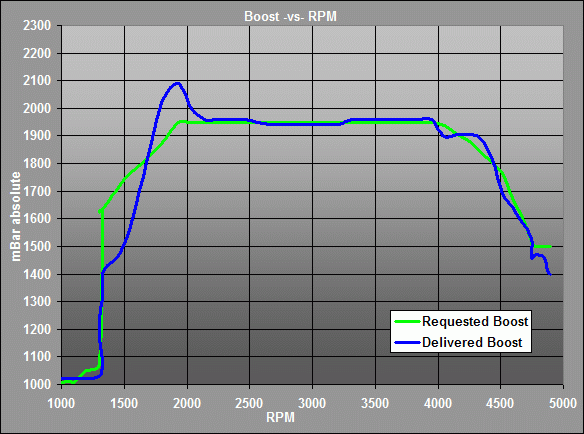I have a 2000 Seat Leon 1.9 TDI (110hp, AHF), about 120,000km.
I have the typical limp mode issues and have logged the behavior. Basically I can get it to limp when full throttle in 4th gear at about 130 kph. It seems difficult to get it to do it in 3rd gear. Fault is standard: "Charge Pressure Control: Positive Deviation"
Is there any way to diagnose more precisely what may the issue based on how the profiles are? Essentially the boost spike seems to be too high initially (I have 2.1 bar is typical) and then it cannot regulate the boost quickly enough (pressure goes up with increasing RPM after the initial attempt at regulation). The two primary symptoms seem to be:
1. Too slow to regulate the initial peak to 2.1 bar (getting 2.5 bar instead)
2. Cannot regulate boost to 1.9 bar under full throttle
3. May not be be related, but my fuel consumption is about 6.5L/100km (44 mpg), which seems a bit low.
(note, my MAF readings look fine)
The turbo was supposedly cleaned around 5000 miles ago (when I complained to the place where I bought it), so I am leaning towards another issue... but can't really be sure. I posted on the previous (same) issue here:
http://www.seatcupra.net/forums/showthread.php?t=280772&page=2
My next three thoughts are that either the N75 valve or the VNT actuator on the turbo are not completely functional. My theory would be that:
1. The N75 valve is malfunctioning and is not causing the appropriate vacuum to be pulled on the VNT actuator, so that the vanes done move as much as they are supposed to.
2. The VNT actuator has malfunctioned or the diaphragm has a leak so that even when the system tries to pull full vacuum on it, it does not have the proper travel to fully actuate the vanes in the turbo, causing overboost... (the only problem with this theory is that I would assume atmospheric pressure means low boost and high vacuum means high boost... is that right?)
3. Leak in a vacuum line or a constricted atmospheric pressure lines so that the N75 doesn't deliver the proper pressure to the VNT actuator?
4. Faulty MAP sensor so that the ECU is getting incorrect pressure readings?
5. Maybe they did a shitty job cleaning the turbo the last time...
Thanks for your help!
My log:

Typical log (per Ross-tech website): Note the efficient regulation of pressure...

I have the typical limp mode issues and have logged the behavior. Basically I can get it to limp when full throttle in 4th gear at about 130 kph. It seems difficult to get it to do it in 3rd gear. Fault is standard: "Charge Pressure Control: Positive Deviation"
Is there any way to diagnose more precisely what may the issue based on how the profiles are? Essentially the boost spike seems to be too high initially (I have 2.1 bar is typical) and then it cannot regulate the boost quickly enough (pressure goes up with increasing RPM after the initial attempt at regulation). The two primary symptoms seem to be:
1. Too slow to regulate the initial peak to 2.1 bar (getting 2.5 bar instead)
2. Cannot regulate boost to 1.9 bar under full throttle
3. May not be be related, but my fuel consumption is about 6.5L/100km (44 mpg), which seems a bit low.
(note, my MAF readings look fine)
The turbo was supposedly cleaned around 5000 miles ago (when I complained to the place where I bought it), so I am leaning towards another issue... but can't really be sure. I posted on the previous (same) issue here:
http://www.seatcupra.net/forums/showthread.php?t=280772&page=2
My next three thoughts are that either the N75 valve or the VNT actuator on the turbo are not completely functional. My theory would be that:
1. The N75 valve is malfunctioning and is not causing the appropriate vacuum to be pulled on the VNT actuator, so that the vanes done move as much as they are supposed to.
2. The VNT actuator has malfunctioned or the diaphragm has a leak so that even when the system tries to pull full vacuum on it, it does not have the proper travel to fully actuate the vanes in the turbo, causing overboost... (the only problem with this theory is that I would assume atmospheric pressure means low boost and high vacuum means high boost... is that right?)
3. Leak in a vacuum line or a constricted atmospheric pressure lines so that the N75 doesn't deliver the proper pressure to the VNT actuator?
4. Faulty MAP sensor so that the ECU is getting incorrect pressure readings?
5. Maybe they did a shitty job cleaning the turbo the last time...
Thanks for your help!
My log:

Typical log (per Ross-tech website): Note the efficient regulation of pressure...

Last edited:









